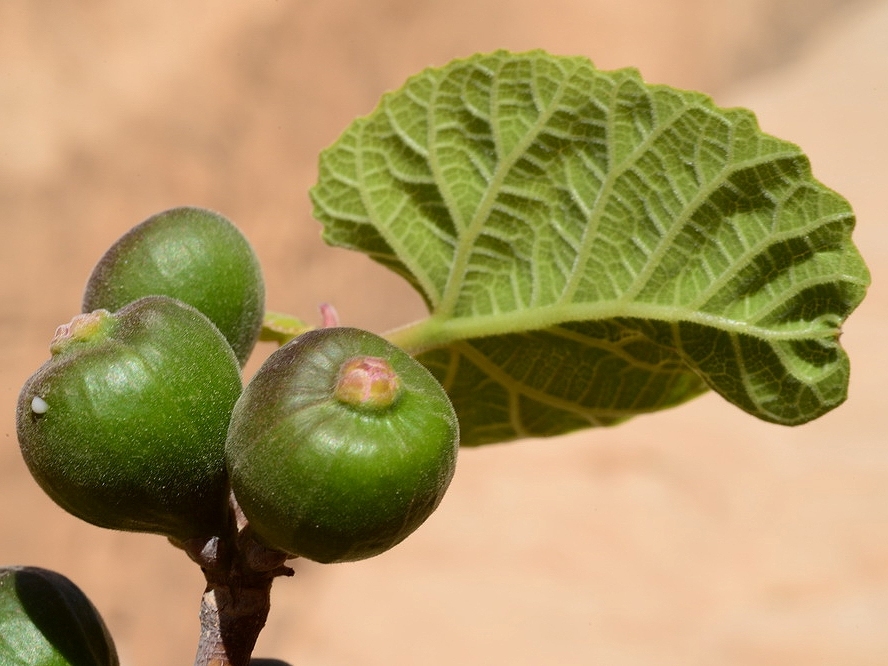This site contains affiliate links for which I may be compensated.
Ficus Palmata
Ficus Palmata Information


-
Possible Synonyms / AKA:
Bedu, Wild Fig, Himalayan Fig, Punjab
-
Introduced By:
-
Origin:
India -
Main Flavor Group:
-
Family Group:
-
Fig Type:
Species -
Cold Hardy:
No -
Container Variety:
N/A -
Easy Rooting:
N/A -
Main Season:
any -
Availability:
Difficult -
Breba Crop:
N/A -
Seed Crunch:
N/A -
Eye:
N/A -
Skin Toughness:
N/A -
Fruit Size:
N/A -
Rain Resistance:
Excellent -
Tree Vigor:
Vigorous -
External Links:
https://www.figdatabase.com/uploads/A%20review%20on%20Ficus%20palmata.pdf
https://youtu.be/Juyo_rlFIxw
http://forums.gardenweb.com/discussions/1884329/is-mosaic-virus-carried-in-all-fig-trees?n=22
http://forums.gardenweb.com/discussions/1882055/ficus-palmata-and-its-hybrids?n=14
https://www.ourfigs.com/forum/figs-home/209602-ficus-palmata-fig
http://vhd.heritagecouncil.vic.gov.au/places/71511
http://vhd.heritagecouncil.vic.gov.au/places/71512
https://indiabiodiversity.org/species/show/266612
Description
This is not a ficus carica, but is a wild cousin of the domesticated Ficus Carica and grows much larger and more vigorously. It grows wild in the Himalayas. It appears to be Graft compatible with Carica and extremely vigorous to boot. Specimens of Ficus Pseudocarica are often misidentified as Ficus Palmata. It also seems to be FMV resistant and figs that are Palmata X Carica are also FMV resistant (such as Alma). It is a Black fig that is good tasting when mature.
Ficus palmata is a highly variable and common wild fig occurring in North West hills on hot, dry slopes in clay soils in Uttarakhand, Punjab and Kashmir in India, Nepal, Pakistan, Afghanistan, Iran, Arabian Peninsula, Somalia, Sudan, Ethiopia and South Egypt.
From Useful Tropical Plants
General Info: Ficus Palmata is a Deciduous shrub or much-branched small tree growing up to 5 meters tall. The plant is often gathered from the wild for its edible fruits and young shoots. It is often cultivated for its fruit in India and Ethiopia and has been recommended for commercial cultivation. The fruits are often sold in local markets in the Himalayas.
Range: Northeast Africa - Egypt, Eritrea, Ethiopia, Somalia, Sudan; through Arabia and temperate Asia to northern India, Nepal and Pakistan.
Known Hazards: The sap and the half-ripe fruits are said to be poisonous.
Habitat: Occasionally found in forests, more commonly around villages, in waste ground, fields etc. Open places, generally along the banks of streams at elevations of 600 - 2,700 meters in Nepal.
Cultivation: A plant of the warm temperate to subtropical zones, also found at higher elevations of 1,000 meters or more in the tropics. Young growth, even on mature plants, is frost-tender. Requires a well-drained medium to light loam and some lime rubble incorporated into the soil. A heavy wet soil tends to encourage excessive plant growth at the expense of fruit. This species has been recommended for growing in areas where the climate is too wet for common figs (Ficus carica) since it fruits during the monsoon season in the Himalayas. However, it probably requires the fig- Wasp in order to pollinate the flowers and so is unlikely to fruit in areas that are too cold for the fig- Wasp to survive. Annual yields from wild trees is about 25kg. There is a potential for commercial cultivation.
Fig trees have a unique form of fertilization, each species relying on a single, highly specialized species of Wasp that is itself totally dependent upon that fig species in order to breed. The trees produce three types of flower; male, a long-styled female and a short-styled female flower, often called the Gall flower. All three types of flower are contained within the structure we usually think of as the fruit.
The female fig Wasp enters a fig and lays its eggs on the short styled female flowers while pollinating the long styled female flowers. Wingless male fig wasps emerge first, inseminate the emerging females and then bore exit tunnels out of the fig for the winged females. Females emerge, collect pollen from the male flowers and fly off in search of figs whose female flowers are receptive. In order to support a population of its pollinator, individuals of a Ficus spp. must flower asynchronously. A population must exceed a critical minimum size to ensure that at any time of the year at least some plants have overlap of emmission and reception of fig wasps. Without this temporal overlap the short-lived pollinator wasps will go locally extinct. Edible Uses: Fruit - raw. Sweet and succulent. A very tasty fruit, it is often dried for later use. The fruit is about 25mm in diameter. The fruit contains about 6% sugars, 1.7% protein, 0.9% ash and 0.2% Pectin . Low in vitamin C, about 3.3mg per 100g. The unripe fruits and young shoots are cooked and eaten as a vegetable. They are boiled, the water is removed by squeezing and they are then fried. A nice green vegetable. Some caution is advised, see notes above on toxicity. Medicinal: The fruit is demulcent, emollient, laxative and poultice. It is used as a part of the diet in the treatment of constipation and diseases of the lungs and bladder. The sap is used in the treatment of warts. The Latex of the plant is used to take out spines lodged deeply in the flesh. Other Uses: The plant is used as a rootstock for the Common Fig (Ficus carica). The pliable wood is of little value but has been used for making hoops, garlands, ornaments etc. Propagation: Seed - sow in a lightly shaded position in a nursery seedbed and only just cover the seed. Prick out the seedlings as soon as they are large enough to handle and plant out when 15cm or more tall. Cuttings of mature wood 10 - 12cm long with a heel. Fairly easy, but the cuttings must be kept frost free. It is probably best if the cuttings are put in individual pots. Layering.
Fig trees have a unique form of fertilization, each species relying on a single, highly specialized species of Wasp that is itself totally dependent upon that fig species in order to breed. The trees produce three types of flower; male, a long-styled female and a short-styled female flower, often called the Gall flower. All three types of flower are contained within the structure we usually think of as the fruit.
The female fig Wasp enters a fig and lays its eggs on the short styled female flowers while pollinating the long styled female flowers. Wingless male fig wasps emerge first, inseminate the emerging females and then bore exit tunnels out of the fig for the winged females. Females emerge, collect pollen from the male flowers and fly off in search of figs whose female flowers are receptive. In order to support a population of its pollinator, individuals of a Ficus spp. must flower asynchronously. A population must exceed a critical minimum size to ensure that at any time of the year at least some plants have overlap of emmission and reception of fig wasps. Without this temporal overlap the short-lived pollinator wasps will go locally extinct. Edible Uses: Fruit - raw. Sweet and succulent. A very tasty fruit, it is often dried for later use. The fruit is about 25mm in diameter. The fruit contains about 6% sugars, 1.7% protein, 0.9% ash and 0.2% Pectin . Low in vitamin C, about 3.3mg per 100g. The unripe fruits and young shoots are cooked and eaten as a vegetable. They are boiled, the water is removed by squeezing and they are then fried. A nice green vegetable. Some caution is advised, see notes above on toxicity. Medicinal: The fruit is demulcent, emollient, laxative and poultice. It is used as a part of the diet in the treatment of constipation and diseases of the lungs and bladder. The sap is used in the treatment of warts. The Latex of the plant is used to take out spines lodged deeply in the flesh. Other Uses: The plant is used as a rootstock for the Common Fig (Ficus carica). The pliable wood is of little value but has been used for making hoops, garlands, ornaments etc. Propagation: Seed - sow in a lightly shaded position in a nursery seedbed and only just cover the seed. Prick out the seedlings as soon as they are large enough to handle and plant out when 15cm or more tall. Cuttings of mature wood 10 - 12cm long with a heel. Fairly easy, but the cuttings must be kept frost free. It is probably best if the cuttings are put in individual pots. Layering.
According to Ira Condit's monograph on fig varieties (1955), the Caprifig of this species has a distinctive Profichi syconium that is purple- Black in color with a long, slender stalk (peduncle). In his classic volume The Fig (1947), Condit describes the syconium as smaller than other varieties of F. carica. In Ficus: The Exotic Species (1969), Condit describes the twigs of F. pseudocarica as velvety pubescent and the twigs of F. carica as glabrous or only slightly puberulent when young. F. pseudocarica is listed as a synonym of F. palmata (Punjab fig) in the Kew List Of Plant Species (2011). It is listed as naturalized in California (under F. palmata) in the Calflora Database and USDA Plant Database. According to the revised Jepson Manual (2011), reports of F. pseudocarica and F. palmata are based on misidentified specimens of F. carica (A.T. Whittemore, 2006, Sida 22: 769-775).
According to Condit (1955), Ficus pseudocarica is native to Eritrea and Abyssinia, while F. palmata is indigenous to Pakistan, northern India and Afghanistan. He states that F. pseudocarica was introduced into Santa Barbara, California in 1902, and like F. palmata, was used for hybridizing with F. carica. In fact, the edible 'Brawley' Caprifig cultivar is a Hybrid between F. carica var. 'kadota' and a F. pseudocaricacaprifig (Storey et al. 1977). Ficus palmata is commonly used in modern floras, with F. pseudocarica listed as a synonym. Alan Whittemore (2006) has studied herbarium collections of F. palmata (F. pseudocarica) from California and has concluded that they are misidentified and should be labeled F. carica. He compared 4 collections of "F. palmata" by H.M. Pollard from Cold Spring Canyon, Santa Barbara Co. during the 1950s with 31 sheets of F. palmata from India, Nepal, Pakistan, Saudi Arabia, Yemen, Eritrea and Ethiopia and 70 sheets of cultivated F. carica worldwide. [Interestingly enough, Pollard's 1950 collections at Rancho Santa Ana Botanic Garden are labeled F. pseudocaria.] Whittemore used 14 characteristics in his analysis of Pollard's sheets, 10 of which matched F. carica better than F. palmata. According to Whittemore, F. palmata (F. pseudocarica) was occasionally grown horticulturally in California, but there is no evidence that it ever escaped from cultivation.
Mallikarjuna Aradhya et al. (2010) studied 194 fig accessions maintained at the USDA National Clonal Germplasm Repository, Davis, California. Their extensive DNA cladogram shows F. pseudocarica on a sister clade with the 'Hacin' cultivar of F. carica, between clades of the popular F. carica cultivars 'Zidi' and 'Roeding.' All of these varieties were derived from the ancestral F. pumila. Under "Materials and Methods," Aradhya et al. cite the single Accession of F. pseudocarica as a synonym of F. palmata. Dna cladograms by Nina Rønsted et al. (2005 and 2006) show F. palmata in a clade far away from F. pumila and certainly not derived from F. pumila. In another cladogram by Rønsted et al. (2008), Ficus pumila (Subsection Frutescentiae) is placed close to F. palmata (Subsection Ficus). In the latter cladogram, the sister clade of F. palmata is F. johannis, another closely-related Deciduous fig in the Ficus carica-F. palmata complex. F. pumila has been artificially crossed with F. carica, indicating a close genetic relationship. It is unfortunate that F. carica was not included in these phylogenetic trees.
The leaves of F. palmata are quite distinctive and match illustrations and photos of the tree in its native habitat from Ethiopia to India; however, according to Condit (1969) the leaves can also be deeply lobed. Condit lists Blastophaga Psenes as the symbiotic pollinator Wasp for F. palmata, the same species found in F. carica. K.J. Joseph (1954) reported B. vaidi for F. palmata in India, but Wiebes and Compton (1990) consider this species of Wasp questionable because it is so similar morphologically to B. psenes. The nonpollinator wasps Sycoscapter forsteni and Philotrypesis palmata are also reported for F. palmata in India (S. van Noort and A. van Harten, 2006). Although the obligate mutualism between pollinating fig wasps and their host fig trees has historically been a one-to-one relationship, more than one species of pollinator Wasp can be associated with a single host and, conversely, a single pollinator can be associated with more than one host fig species (van Noort and van Harten, 2006; van Noort and Rasplus, 2010).
Ficus pseudocarica is an enigma. In the DNA cladogram of Aradhya et al. (2010), the clade of a specimen identified as F. pseudocarica is embedded within clades of F. carica cultivars and yet it is considered synonymous with F. palmata. It seems reasonable to assume that if F. pseudocarica is synonymous with F. palmata and if F. palmata is a valid species, it should be in a clade separate from F. carica. These discrepencies suggest that perhaps some collections identified as F. pseudocarica in California are varieties of F. carica.
During the past two decades, a number of additional fig collections have been made in southern California by reputable botanists who concluded the species was Ficus palmata rather than F. carica. Eight of these are listed by the Consortium of California Herbaria at Rancho Santa Ana Botanic Garden and University of California, Riverside. DNA evidence strongly suggests that these two species are closely related; however, major herbaria such as Kew and Missouri Botanical Garden recognize them as distinct species. Although my 1986 Caprifig collection from Vista, California (RSA381641) has some characteristics matching Condit's description of F. pseudocarica, it is perhaps best treated as a variety of Ficus carica.
In Ficus: The Exotic Species (1969) Condit discusses the difficulty in separating Ficus palmata from F. pseudocarica. In fact, in his Key To Ficus, the two species are not separated. Even the separation between these two species and Ficus carica is only based on the degree of pubescence of young stems. Ficus carica twigs are glabrous or only slightly puberulent, while those of F. pseudocarica and F. palmata are velvety pubescent. Other characteristics, such as leaf shape and size, venation, and the size, shape and color of fruit are so variable that it is difficult to make a positive identification from the key. Under his description of Ficus palmata, Condit cites George King who studied these species in the late 1800s: "I have a strong suspicion that all may be but forms of F. carica Linn." According to the extensive fig website FigWeb (2011), fig biologists Simon van Noort and Jean-Yves Rasplus state that F. palmata and F. carica are probably conspecific. The Principle of Parsimony (Occam's Razor) states that the least complex explanation for an oberservation is probably the best explanation. If F. pseudocarica, F. palmata and F. carica are all taxonomic varieties or subspecies of one species complex, the above discrepencies between DNA analysis and disputed California collections of these species might be resolved!
Here is a PDF file for your convenience: A Review On Ficus Palmata.
If you'd like your banner to be shown here and throughout Fig Database, send us a message.
Photos Add Your Image
No Images Found
YouTube Videos
No Videos Found






